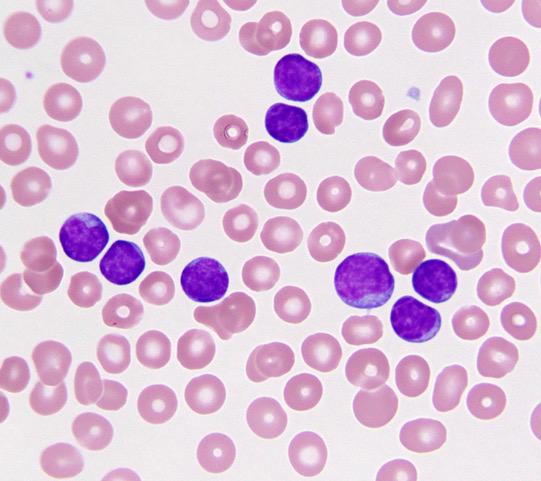Penn study links mutations in notch gene to role in B cell cancers

Peripheral blood with chronic lymphocytic leukemia cells. Image courtesy of Jon Aster, Harvard Medical School
The researchers found that in B cell tumors, mutated overactive versions of the Notch protein directly drive the expression of the Myc gene and many other genes that participate in B cell signaling pathways. Myc is a critical gene in governing cell proliferation and survival, activities that it carries out by regulating the expression of other genes involved in cell metabolism.
B cell signaling pathways are the current targets of several therapies used to treat B cell malignancies such as CLL. “An important translational implication of this research is that we hope that by combining Notch inhibitors with drugs that target B-cell signaling we can better treat these B-cell cancers,” said senior author Warren Pear, MD, PhD, a professor of Pathology and Laboratory Medicine at Penn Medicine.
“Although this is true of many transcription factors, it has been difficult to develop therapeutics that directly target the Myc protein, an alternative approach may be to target the proteins that regulate Myc expression.” Notably, multiple Notch inhibitors are in various stages of clinical development as potential cancer therapies.
The mechanism used by Notch to regulate Myc in B cells is distinct from the mechanism used in other cell types, such as T cells, where Notch also regulates Myc. The team found that Notch uses different regulatory switches in the genome, called enhancers, in different cell types. This raises the issue of why evolution would select for this complexity.
One reason may be that Myc needs to be under very tight control in each cell. For example, in the mouse model of Notch-induced T-cell leukemia, the Penn group previously found that the difference between inducing a T cell tumor or not is a doubling of Myc transcription by Notch. As Notch appears to use cell type-specific machinery to regulate Myc, it may be possible to target the Notch-Myc signaling path in a way that does not disrupt this path in other cell types.
Another surprising finding was the direct link between Notch and genes involved in other B cell signaling pathways. For example, Notch activates genes involved in B cell receptor signaling, which is an established drug target in these B cell cancers.
The challenge now will be to understand what this might mean for treatment of patients with Notch-activated B-cell leukemias and lymphomas. The team plans to test the synergy between Notch and B-cell signaling inhibitors. If they find a relationship, the next step would be to stimulate interest in a clinical trial.
###
The study is collaboration between the Pear laboratory, including co-first author Jelena Petrovic and the lab of Roberty Faryabi, PhD at Penn, along with the labs of Brad Bernstein and Jon Aster, Harvard Medical School. Co-first author Russell Ryan, from the Bernstein lab, is now an assistant professor at the University of Michigan.
This work was funded by the National Institutes of Health (P01 CA119070, R01AI047833, U01HL100405), the Leukemia and Lymphoma Society, the Penn Epigenetics Institute, a Financial Peace University fellowship, a National Marfan Foundation Award, the Burroughs Wellcome Fund, and grants from the Spanish government and Red Tematica de Investigacia Cooperativa en Cancer.
Penn Medicine is one of the world's leading academic medical centers, dedicated to the related missions of medical education, biomedical research, and excellence in patient care. Penn Medicine consists of the Raymond and Ruth Perelman School of Medicine at the University of Pennsylvania (founded in 1765 as the nation's first medical school) and the University of Pennsylvania Health System, which together form a $6.7 billion enterprise.
The Perelman School of Medicine has been ranked among the top five medical schools in the United States for the past 20 years, according to U.S. News & World Report's survey of research-oriented medical schools. The School is consistently among the nation's top recipients of funding from the National Institutes of Health, with $392 million awarded in the 2016 fiscal year.
The University of Pennsylvania Health System's patient care facilities include: The Hospital of the University of Pennsylvania and Penn Presbyterian Medical Center — which are recognized as one of the nation's top “Honor Roll” hospitals by U.S. News & World Report — Chester County Hospital; Lancaster General Health; Penn Wissahickon Hospice; and Pennsylvania Hospital — the nation's first hospital, founded in 1751. Additional affiliated inpatient care facilities and services throughout the Philadelphia region include Good Shepherd Penn Partners, a partnership between Good Shepherd Rehabilitation Network and Penn Medicine.
Penn Medicine is committed to improving lives and health through a variety of community-based programs and activities. In fiscal year 2016, Penn Medicine provided $393 million to benefit our community.
Media Contact
All latest news from the category: Life Sciences and Chemistry
Articles and reports from the Life Sciences and chemistry area deal with applied and basic research into modern biology, chemistry and human medicine.
Valuable information can be found on a range of life sciences fields including bacteriology, biochemistry, bionics, bioinformatics, biophysics, biotechnology, genetics, geobotany, human biology, marine biology, microbiology, molecular biology, cellular biology, zoology, bioinorganic chemistry, microchemistry and environmental chemistry.
Newest articles

High-energy-density aqueous battery based on halogen multi-electron transfer
Traditional non-aqueous lithium-ion batteries have a high energy density, but their safety is compromised due to the flammable organic electrolytes they utilize. Aqueous batteries use water as the solvent for…

First-ever combined heart pump and pig kidney transplant
…gives new hope to patient with terminal illness. Surgeons at NYU Langone Health performed the first-ever combined mechanical heart pump and gene-edited pig kidney transplant surgery in a 54-year-old woman…

Biophysics: Testing how well biomarkers work
LMU researchers have developed a method to determine how reliably target proteins can be labeled using super-resolution fluorescence microscopy. Modern microscopy techniques make it possible to examine the inner workings…





















